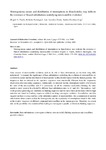Heterogeneous nature and distribution of interruptions in dinucleotides may indicate the existence of biased substitutions underlying microsatellite evolution

Use this link to cite
http://hdl.handle.net/2183/21420Collections
- Investigación (FCIE) [1232]
Metadata
Show full item recordTitle
Heterogeneous nature and distribution of interruptions in dinucleotides may indicate the existence of biased substitutions underlying microsatellite evolutionDate
2008-06Citation
Heterogeneous nature and distribution of interruptions in dinucleotides may indicate the existence of biased substitutions underlying microsatellite evolution Miguel A. Varela, Roberto Sanmiguel, Ana Gonzalez-Tizón, Andrés Martínez-Lage, J Mol Evol., (2008), 66(6): 575–580.
Abstract
[Abstract] Some aspects of microsatellite evolution, such as the role of base substitutions, are far from being fully understood. To examine the significance of base substitutions underlying the evolution of microsatellites we explored the nature and the distribution of interruptions in dinucleotide repeats from the human genome. The frequencies that we inferred in the repetitive sequences were statistically different from the frequencies observed in other noncoding sequences. Additionally, we detected that the interruptions tended to be towards the ends of the microsatellites and 5′-3′ asymmetry. In all the estimates nucleotides forming the same repetitive motif seem to be affected by different base substitution rates in AC and AG. This tendency itself could generate patterning and similarity in flanking sequences and reconcile these phenomena with the high mutation rate found in flanking sequences without invoking convergent evolution. Nevertheless, our data suggest that there is a regional bias in the substitution pattern of microsatellites. The accumulation of random substitutions alone cannot explain the heterogeneity and the asymmetry of interruptions found in this study or the relative frequency of different compound microsatellites in the human genome. Therefore, we cannot rule out the possibility of a mutational bias leading to convergent or parallel evolution in flanking sequences.
Keywords
Base substitutions
Convergent evolution
Erosion model
Flanking sequences
Microsatellites
Parallel evolution
Convergent evolution
Erosion model
Flanking sequences
Microsatellites
Parallel evolution
Editor version
Rights
This is a post-peer-review, pre-copyedit version of an article published in [Journal of Molecular Evolution]. The final authenticated version is available online at: [https://doi.org/10.1007/s00239-008-9107-3].
ISSN
1432-1432
0022-2844
0022-2844





